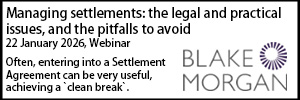Stress testing: Hatton and Sutherland ten years on
- Details
 In the first of two articles, Roy Woollard looks at developments in workplace stress claims.
In the first of two articles, Roy Woollard looks at developments in workplace stress claims.
Stress is particularly topical with regards to the public sector since the three most vulnerable occupations are said to be teaching, social work and public sector work generally; the research identifying these occupations pre-dates the credit crunch and austerity cuts.
What is stress?
The HSE says it is: “the adverse reaction people have to excessive pressure or other types of demands placed on them”.
The key here is the adverse nature of the reaction – not necessarily the pressure exerted.
More significantly, ‘stress’ is not by itself sufficient to form the basis of a claim. The stress must result in a recognised medical condition – usually psychological but also possibly physical (from palpitations to a heart attack).
The basic principles of tort apply to such claims. A claimant must establish a duty of care, a breach of that duty and foreseeable risk of injury, along with causation in respect of any injury.
Experience shows that there are certain trends which emerge from ‘traditional’ common law stress cases as certain types of situation crop up again and again as precipitating or causal factors. Examples include:
- Excessive workload – due to poor management, pressure on resources or high staff turnover.
- Over-promotion.
- Target-driven goal setting.
- Insufficient training.
- Organisational change.
- Role and reporting line ambiguity.
- Inter-personal issues, usually between direct line management links.
Essentially a claimant must show that his/her employer knew or should have known that he was at risk of suffering psychiatric injury, either from previous absences or as a result of complaints made. This must be more than simple employee grumbles and must be enough to put a reasonable employer on notice that they should act. The claimant must go on to show that in light of this knowledge, the employer failed to take reasonable steps to prevent the harm occurring. This could include reducing an employee’s workload or removing them from working with an alleged bully.
The need for injury to be foreseeable is highlighted in the judgment in Garrett v Camden LBC (2001) CA: “Unless … there was a real risk of breakdown which the claimant’s employers ought reasonably to have foreseen and they ought properly to have averted there can be no liability”.
Although stated in the negative, the two steps to the test are clear: the employer must:
- be on notice of likely injury, and
- have failed to take appropriate action to deal with this.
The first case of its kind, Walker v Northumberland CC (1994) clearly illustrates this point. The claimant was a social worker in charge of a team whose workload involved handling child abuse cases. He reported stress to the council and when nothing was done about this he suffered a nervous breakdown. On his return to work insufficient action was taken to protect him from further excessive stress despite complaints and he suffered a second breakdown. There was no liability for the first one as the employer was not on notice. On the second occasion when nothing had been done in between ‘to alleviate the stress’ (the court’s words), when it could and should have been done, liability flowed to the council.
As further examples – in 2005 the CA decided two ‘pub’ cases.
Hone v Six Continents Retail Ltd, 2005, CA
The claimant took over management of The Moathouse, Luton. He was working 90 hours a week and asked for an assistant. He did not get an assistant, two workers left and he was doing even more work – with no breaks. He asked again for an assistant – again this was refused.
The area manager visited when the claimant would not sign the working time directive waiver. The situation was known to the manager but despite promises, nothing changed.
The claimant broke down, went off sick and sued for stress – and won.
Harding v Pub Estates Co Ltd, 2005, CA
The claimant took over The Antelope, one of the toughest pubs in Manchester. Criminal activity was rife within the pub and the area. The stresses and strains for the claimant were enormous and he had a heart attack.
However, despite his protestations, the evidence showed that he had not informed his GP or employer of the effect the stress was having on his health.
Since the employer was not therefore on notice, the claim failed.
Hatton v Sutherland (2002) CA
The Court of Appeal heard four cases together and it set down 16 propositions which have become something of a checklist when looking to pursue or defend such claims. These are viewed as ‘setting the bar very high’ for workplace stress claims.
Hatton ten years on
Incredibly, there was a setback almost immediately. One of the four cases heard, Barber v Somerset, appealed to the HL and won! The HL approved of the 16 propositions but not the ‘height of the bar’ in this particular teacher stress case.
Even so, Hatton has remained good law to this day, save for one exception (see below).
Mullen v Accenture Services (2010) is a clear reminder of how high the bar still is. Mr Mullen, a top-level computer programmer, joined the firm in 2004. He was contracted to, inter alia, the Williams F1 Team, then he worked in Leeds on a complex project for the ambulance service. It was whilst involved in this project that he claimed he was made ill as he was bullied and also overworked by his line manager. He gave evidence of long hours, forgetfulness, lack of lunch breaks and bursting into tears – and suggested that these should put the employer on notice of his impending mental breakdown.
Not enough, said the court. Furthermore, the fact that he had a history of psychiatric illness had no bearing because he had not told his employer until after this breakdown. The employer was not on notice. The case was dismissed.
More recently, by far the biggest public sector case has been Erica Connor v Surrey CC (2010) CA. The claimant head teacher succeeded against the local authority employer when political correctness (and accusations of Islamaphobia) got in the way of the duty of care to the employee. The settlement figure was just short of £400,000.
The counselling shield
Proposition 11 of Hatton says: “An employer who offers a confidential advice service with referral to appropriate counselling or treatment services, is unlikely to be found in breach of duty.”
This survived until 2007, when the CA was asked to accept it as a full defence against a claim.
Daw v Intel (2007) CA: “There will be cases in which an employee may be expected to take refuge in counselling services … but … the reference … in Hatton does not make such services a panacea (in order to) discharge their duty of care.”
Because of the attempted use of proposition 11 as a defence once more, the status of the Hatton principles as a whole was unceremoniously pegged back a year later by Smith LJ: Dickens v O2 plc (2008) (on counselling): “the reliance on Hale LJ’s summary in Hatton… serves to demonstrate how dangerous it is to apply guidance given by the court as though it were a statutory provision”.
Conclusion
Notwithstanding all of the above, the difficulty for claimants to establish a successful case of stress at work remains, with the bar still set high.
Such cases should therefore be defended robustly. However, read our next article whereby the matter of harassment in the workplace brings a distinctly more worrying trend to the developing case law.
Roy Woollard is a Partner and former head teacher at Berrymans Lace Mawer. He can be contacted by










